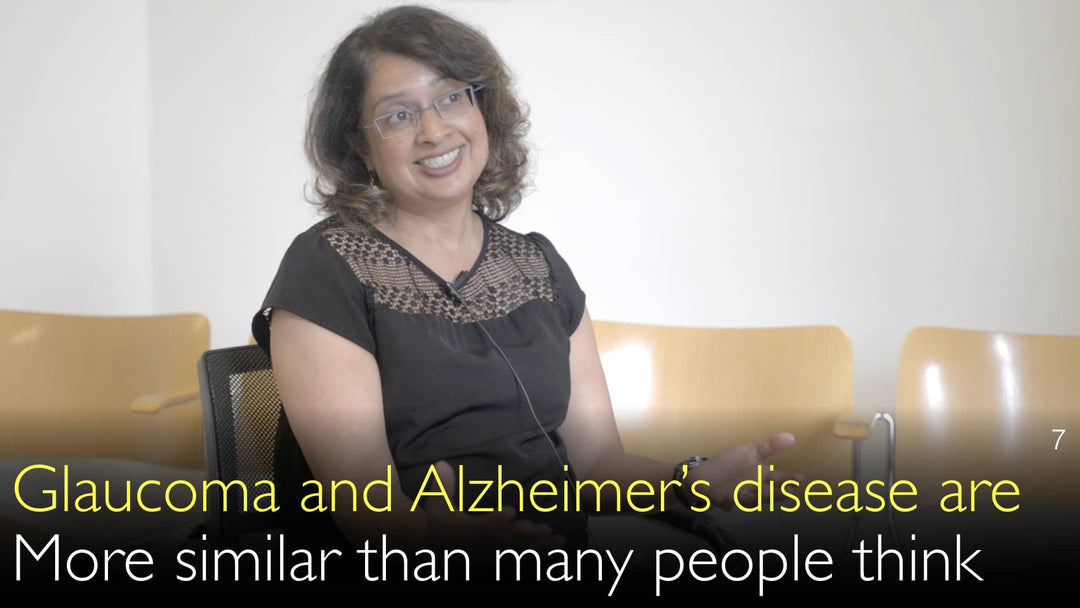Leading expert in neurodegeneration and eye diseases, Dr. Francesca Cordeiro, MD, explains the profound biological links between glaucoma, Alzheimer’s disease, and Parkinson’s disease. She details how these conditions share common embryological origins, neurodegenerative mechanisms like beta-amyloid deposition and mitochondrial dysfunction, and similar triggers such as repetitive trauma. Dr. Francesca Cordeiro, MD, highlights the eye's role as a window to the brain, offering a more accessible path for early diagnosis and the potential for developing overlapping treatment strategies for these neurodegenerative disorders.
Understanding the Link Between Glaucoma and Neurodegenerative Brain Diseases
Jump To Section
- The Eye and Brain Connection
- Shared Neurodegenerative Mechanisms
- Trauma and Stress Link
- Beta-Amyloid's Role in Diagnosis
- Mitochondrial Dysfunction in Cell Death
- Diagnostic Advantages of the Eye
- Future Treatment Implications
The Eye and Brain Connection
The eye develops directly from the brain during early embryology, a fact that establishes a fundamental biological link between ocular and cerebral health. Dr. Francesca Cordeiro, MD, explains that retinal cells originate from the same progenitor cells that form the brain. This shared developmental origin makes it understandable that neurodegenerative processes affecting the brain would also manifest in the eye.
Shared Neurodegenerative Mechanisms
Glaucoma, Alzheimer’s disease, and Parkinson’s disease are all characterized by a progressive loss of neurons through overlapping pathogenic mechanisms. Dr. Francesca Cordeiro, MD, notes that the downstream events and cellular processes that lead to nerve cell death are common across these conditions. This significant overlap means that therapeutic strategies developed for one neurodegenerative disease could potentially be effective for treating others, including glaucoma.
Trauma and Stress Link
Repetitive physical trauma is a known risk factor for triggering neurodegenerative pathways in the brain, and a similar mechanism is theorized for the eye. Dr. Francesca Cordeiro, MD, describes how in glaucoma, cyclical elevation of intraocular pressure creates a pounding trauma at the back of the eye. This is analogous to the repeated head trauma that contributed to Muhammad Ali's Parkinson's disease and the brain injury linked to Alzheimer's in boxers, highlighting a common stress-induced injury model.
Beta-Amyloid's Role in Diagnosis
The abnormal deposition of beta-amyloid protein is a hallmark of Alzheimer’s disease and is now also implicated in glaucoma pathology. Dr. Francesca Cordeiro, MD, discusses how a lumbar puncture to analyze cerebrospinal fluid for low beta-amyloid levels is a diagnostic method for Alzheimer's, as the protein deposits in the brain. Crucially, a Japanese study found a reduction of beta-amyloid in the vitreous humor of glaucoma patients, indicating similar deposition in the retina and a much higher incidence of Alzheimer's within that glaucoma cohort.
Mitochondrial Dysfunction in Cell Death
Impaired mitochondrial function is a central mechanism of energy failure and nerve cell death across major neurodegenerative diseases. Dr. Francesca Cordeiro, MD, clarifies that mitochondria are the energy-producing components of cells, and neurons are particularly dependent on this energy for signaling. The type of mitochondrial injury observed in Parkinson's and Alzheimer's is identical to the cellular injury found in glaucoma, further solidifying the pathological overlap between these conditions.
Diagnostic Advantages of The Eye
The eye provides a uniquely accessible window to the brain for diagnosing and monitoring neurodegeneration. During his discussion with Dr. Cordeiro, Dr. Anton Titov, MD, highlights the clinical challenge of imaging the brain through the bony skull with expensive MRI or PET scans. In contrast, the transparent structures of the eye allow for non-invasive, direct visualization of neural tissue, offering a promising avenue for earlier and easier detection of diseases like Alzheimer's.
Future Treatment Implications
The extensive commonality between these diseases opens exciting possibilities for developing novel neuroprotective treatments. Dr. Cordeiro’s research suggests that a therapy designed to target a specific cell death pathway in Alzheimer's could be equally effective for treating glaucoma. This convergent approach to drug development could accelerate the discovery of treatments that halt neurodegeneration in both the eye and the brain, ultimately preserving vision and cognitive function for patients.
Full Transcript
Eye develops from the brain. Neurodegenerative processes in Alzheimer’s disease, Parkinson’s disease, and glaucoma overlap. Leading eye diseases and neurodegeneration expert explains.
Dr. Anton Titov, MD: Glaucoma is the eye disease characterized by increased pressure in the eye. Alzheimer's disease is characterized by the neurodegenerative process in the brain. Yet glaucoma and Alzheimer's are overlapping in their pathogenesis mechanisms. They have certain similar features.
Your research focuses on aspects of neurodegeneration both in the eye and the brain. Please discuss in more detail the overlap in neurodegeneration in Alzheimer's disease, glaucoma, and other neurodegenerative diseases of the eye.
Dr. Francesca Cordeiro, MD: Sure. That's a very interesting question. A lot of patients don't realize that the eye develops from the brain. Let’s look at the early stages of embryology. These cells then go on into active development of the eyes. Retinal cells come from the same cells that form the brain.
It's not that difficult to imagine, therefore, that the processes that affect the brain also affect the eye. Look at the medical research literature. The use of the eye is a window to the brain has been proposed for many years. Because eye is much more accessible than the brain.
The brain has a bony skull that is quite difficult to image through. You have to use expensive diagnostic tests such as an MRI or a PET scanner. In Alzheimer’s disease you have brain cell death. There are downstream events and processes leading to cell death.
There are disease processes that are common to all of these neurodegenerative diseases. That's one of the reasons why the strategies for targeting these diseases can be used in Alzheimer’s disease. The same therapy strategies would be used in glaucoma.
What is interesting is this. There is some evidence that the mechanism that starts the glaucoma eye disease may be also common. One theory is that in glaucoma the elevation of the pressure is cyclical. You have almost like a pounding in the back of the eye. That creates a trauma. It is stress-related response.
Dr. Anton Titov, MD: Boxer Muhammad Ali had Parkinson's disease. One reason for his Parkinson’s disease was the fact that he had repeated head trauma. That was one of the causes for how he had a stress-induced brain injury. Cyclical brain damage.
Dr. Francesca Cordeiro, MD: Absolutely. The same problem happens in Alzheimer’s diseases. There is quite a lot of evidence that boxers develop Alzheimer's disease because they are repeatedly damaging the brain against the skull. So, that's a commonality.
There is also this link with the plaques. In Alzheimer's eye disease you have plaques and tangles in the brain. The brain plaques are formed by a protein called beta amyloid. Then the neurofibrillary tangles are formed by tau.
We have a theory that what happens is this. Beta amyloid is not being cleared away properly from the brain. It is deposited in the brain. This is the result of some neurotoxic stress. Sometimes you have beta amyloid in the brain. Then you get more nerve cell death.
One of the more recent ways of diagnosing Alzheimer's eye disease is to do a lumbar puncture. You take a sample of the cerebrospinal fluid. Cerebrospinal fluid ensheathes the spine and the brain. You look for the level of beta amyloid. Some patients have a reduced beta amyloid level. Then what's happened is it's been deposited in the brain. Beta amyloid is believed to be an early indicator of Alzheimer’s disease.
Dr. Anton Titov, MD: It is very interesting.
Dr. Francesca Cordeiro, MD: A very similar phenomenon has been found in a group of glaucoma patients in Japan. They showed that they looked at the jelly of the eye, vitreous body. They looked for the presence of this beta amyloid. In patients who had glaucoma, there was a reduction in beta amyloid. In other words, beta amyloid had been deposited in the retina.
In that same glaucoma group of patients the incidence of Alzheimer's eye disease was much higher than in the normal population. So, there was that link as well.
Then, thirdly, the other mechanism for neurodegeneration in glaucoma that has been put forward. This is common to all of these diseases is mitochondria. Mitochondria are this sort of energy bits of your cell. They make energy. Mitochondria allow your cells to be active.
Nerve cells, in particular, need a lot of energy to function. Because they're allowing signals to be passed going up to the brain. Things that cause mitochondrial injury in diseases such as Parkinson's disease and Alzheimer's are exactly the same. Injury is similar to the cellular injury in glaucoma.
The overlap in glaucoma and Alzheimer’s disease and Parkinson’s disease is quite large. It extends from the embryology, the development of the embryo, and to how you get the mechanism of nerve cell death.
Dr. Anton Titov, MD: There is a lot of commonality between these diseases, glaucoma and Alzheimer’s disease, and between Parkinson’s disease.







